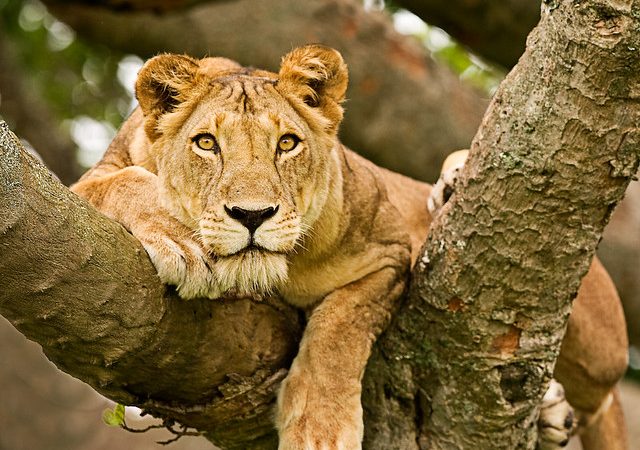
Queen Elizabeth National Park is one of Uganda’s most diverse and wildlife-rich destinations. Although smaller than Murchison Falls National Park, it is home to more than 95 species of mammals and over 600 bird species, making it one of Africa’s most rewarding safari parks. The park is famous for its tree-climbing lions, chimpanzees, and the scenic Kazinga Channel, where countless animals gather daily.
Chimpanzees in Kyambura Gorge
Among the most fascinating animals in Queen Elizabeth National Park are the chimpanzees, found in the lush Kyambura Gorge—often called the “Valley of Apes.” These highly intelligent primates live alongside other species such as black-and-white colobus monkeys, red-tailed monkeys, and blue monkeys.
Chimpanzee tracking in Kyambura Gorge offers visitors a 50% chance of encountering these endangered primates in their natural habitat. The experience is both thrilling and educational, as visitors observe the chimps’ social behavior and hear their distinctive calls echo through the forest.
Large Mammals Animals in Queen Elizabeth National Park
The park’s open savannahs and wetlands support a large population of buffaloes, elephants, hippopotamuses, and warthogs.
-
Buffaloes: Over 1,000 roam freely through the park.
-
Hippos: With more than 5,000 individuals, Queen Elizabeth National Park has one of the highest concentrations of hippos in Africa, often seen wallowing in the Kazinga Channel.
-
Elephants: Frequently spotted during game drives and boat cruises, especially along Lake George and the Kazinga Channel.
Game drives provide excellent opportunities to see these animals up close, while boat cruises along the Kazinga Channel offer a unique perspective of wildlife gathering at the water’s edge.
Other Wildlife Species
The park is also home to Ugandan kobs, waterbucks, sitatunga antelopes, forest hogs, and banded mongooses, particularly around the Mweya Peninsula. These herbivores and small mammals contribute to the rich biodiversity that makes Queen Elizabeth National Park a must-visit safari destination.
Tree-Climbing Lions in Ishasha Sector
One of the park’s biggest highlights is the tree-climbing lions found in the Ishasha Sector, in the southern part of the park. These lions are often seen resting high up in fig trees or acacia trees, an unusual behavior not commonly observed elsewhere in Africa.
There are several theories behind this behavior:
-
They climb to escape biting insects such as tsetse flies on the ground.
-
The trees provide cool breezes and a good vantage point for spotting prey on the vast savannah plains.
Seeing these unique lions lounging in the trees is an unforgettable experience for visitors.
Nocturnal Animals and Predators
Queen Elizabeth National Park also hosts several nocturnal animals, including leopards, civets, genets, and serval cats.
Leopards, often seen during night game drives, are masters of camouflage and move silently through the bush. Smaller nocturnal cats like servals and genets can also be spotted after dark, adding excitement to evening safaris.
Conclusion
From chimpanzees in Kyambura Gorge to the rare tree-climbing lions of Ishasha, Queen Elizabeth National Park offers one of the most diverse wildlife experiences in Uganda. Whether you’re cruising along the Kazinga Channel, tracking primates, or exploring the savannah plains on a game drive, the park guarantees a truly unforgettable safari adventure.



